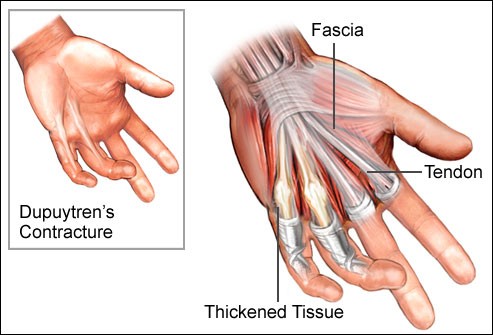Dupuytren's-disease

Dupuytren’s (du-pwe-TRANZ) contracture is a hand deformity that usually develops over the years. The condition affects a layer of tissue that lies under the skin of your palm. Knots of tissue form under the skin — eventually creating a thick cord that can pull one or more fingers into a bent position.
The affected fingers can’t be straightened completely, which can complicate everyday activities such as placing your hands in your pockets, putting on gloves or shaking hands. Dupuytren’s contracture mainly affects the two fingers farthest from the thumb and occurs most often in older men of Northern European descent. A number of treatments are available to slow the progression of Dupuytren’s contracture and relieve symptoms.
Symptoms
Dupuytren’s contracture typically progresses slowly, over years. The condition usually begins as a thickening of the skin on the palm of your hand. As it progresses, the skin on your palm might appear puckered or dimpled. A firm lump of tissue can form on your palm. This lump might be sensitive to the touch but usually isn’t painful.
In later stages of Dupuytren’s contracture, cords of tissue form under the skin on your palm and can extend up to your fingers. As these cords tighten, your fingers might be pulled toward your palm, sometimes severely.
The two fingers farthest from the thumb are most commonly affected, though the middle finger also can be involved. Only rarely are the thumb and index finger affected. Dupuytren’s contracture can occur in both hands, though one hand is usually affected more severely.
Causes:
Doctors don’t know what causes Dupuytren’s contracture. There’s no evidence that hand injuries or occupations that involve vibrations to the hands cause the condition. A number of factors are believed to increase your risk of the disease, including:
✔Age: Dupuytren’s contracture occurs most commonly after the age of 50.
✔Ancestry. People of Northern European descent are at higher risk of the disease.
✔Family history: Dupuytren’s contracture often runs in families.
✔Tobacco and alcohol use: Smoking is associated with an increased risk of Dupuytren’s contracture, perhaps because of microscopic changes within blood vessels caused by smoking. Alcohol intake also is associated with Dupuytren’s.
✔Diabetes: People with diabetes are reported to have an increased risk of Dupuytren’s contracture.
Treatment
If the disease progresses slowly, causes no pain and has little impact on your ability to use your hands for everyday tasks, you might not need treatment. Instead, you can wait and see if Dupuytren’s contracture progresses. You may wish to follow the progression with a tabletop test, which you can do on your own.
Treatment involves removing or breaking apart the cords that are pulling your fingers toward your palm. This can be done in several ways. The choice of procedure depends on the severity of your symptoms and other health problems you may have.
